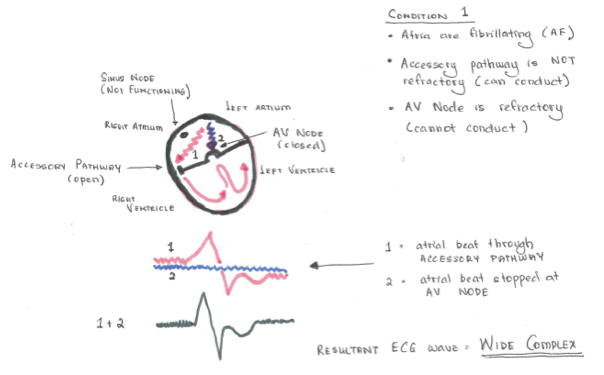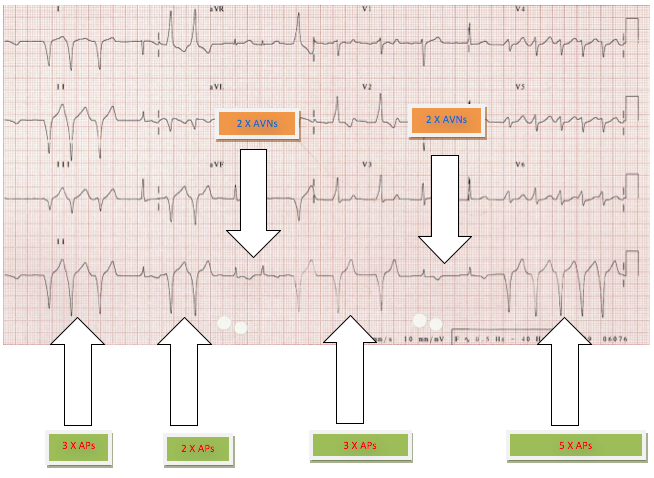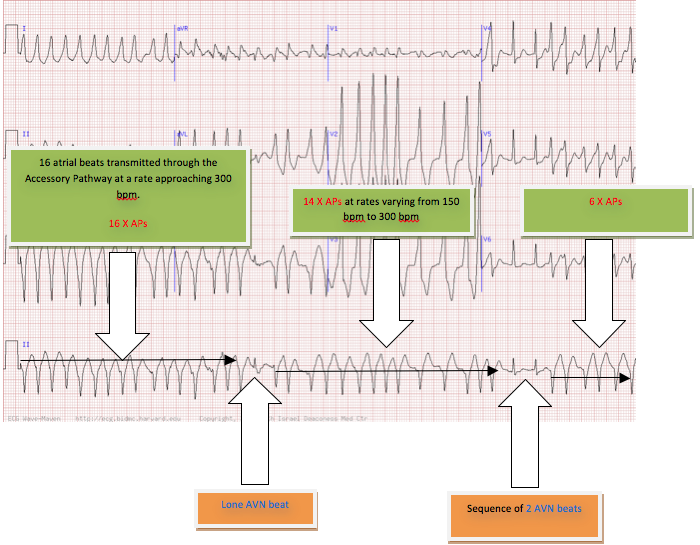A group of disorders commonly bundled together and known as Pre-excitation Syndromes. Incidence is quite uncommon at 0.1 to 0.3 % of the population. Of these, incidence of sudden cardiac death is rare. A favourite of ECG enthusiasts as there are classical ECG changes in a number of cases, known as a delta wave at the start of the QRS complex.
First let us review the classical ECG seen in WPW Sinus Rhythm below:
Next, we’ll look at what happens when the atria contract in a chaotic fashion. To identify the ECG that is produced, we must know a little about ECGs that we look at.
First, the ECG that is printed out of the ECG machine is SUMMATIVE, i.e., that deflections of P, QRS and T waves are a sum of vectors of depolarisation and repolarisation as seen by each individual lead. For WPW in sinus rhythm (above) the ECG that is produced is a sum of (1+2+3), hence the short PR and delta wave, with a smaller T wave.
Second, the AV node has a much longer refractory period that the Accessory pathway. This also means that the AV node can physically conduct any beat into the ventricles to a maximum heart rate of about 180 beats per minute in the adult. Whereas the Accessory pathway can conduct an atrial beat into the ventricles at nearly 300 beats per minute.
We do not normally see heart rates in excess of 250 bpm because normal ventricular tissue is usually limited physiologically to a rate of 250 bpm. Thus it acts as its own brake to prevent exhaustion. Ventricular tissue, atrial tissue and the conducting system (SA node, AV node, Bundle of His, Left Bundle Brach and Right Bundle Branch) have its own and different upper and lower limits of conduction.
So, let’s tackle WPW AF!!
There are a couple of important assumptions that have to be noted for us to understand this ECG. They are:
- The atrial contraction is chaotic and constant at about 300 – 500 contractions per minute.
- The atrial beat conducted through the AV node will produce a narrow complex beat.
- The atrial beat conducted through the Accessory pathway will produce a wide complex beat.
- The Accessory pathway is either OPEN (not refractory and can conduct an atrial contraction) and CLOSED (refractory, unable to conduct an atrial contraction).
- The AV Node is either OPEN and CLOSED too.
The AV node is open 3 times a second. This gives us a rate limit of 180 bpm.
The Accessory pathway is open 5 times a second. This gives us a rate limit of 300 bpm.
There are 2 conditions where an atrial beat can be transmitted into the ventricles:
- Condition 1 where the Accessory pathway is OPEN and the AV Node is CLOSED.
- Condition 2 where the Accessory pathway is CLOSED and the AV Node is OPEN.
So, in condition 1, the atria are contracting at 300 – 500 bpm. The Accessory pathway is OPEN and the AV node is CLOSED. Let’s see what happens to the atrial contraction:
Thus we end up with a Wide Complex beat. Remembering that AF is irregularly irregular, we get an
IRREGULARY IRREGULAR WIDE COMPEX TACHYCARDIA
But sometimes the AV Node is OPEN and the Accessory pathway is CLOSED. This sets up condition 2, which we will look at next.
In condition 2, the Accessory pathway is CLOSED and the AV node is OPEN. Let us now follow the atrial impulse from the chaotic atria to the ventricle:
Thus we end up with a Narrow Complex beat, with an underlying AF which is
IRREGULARLY IRREGULAR NARROW COMPLEX TACHYCARDIA
If we put the two ECGs in sequence we get an:
IRREGULARLY IRREGULAR WIDE and NARROW COMPLEX TACHYCARDIA
Now when we look at an ECG of WPW AF, we can identify atrial contractions transmitted through the Accessory pathway (AP) or the AV node (AVN) as shown below.
Example 1:
WPW AF at a slow rate:
Example 2:
WPW AF at a fast rate:
Here is the ECG we are most familiar with in a clinical or exam setting.
My interpretation is as follows:
- irregularly irregular ventricular rate at between 150 – 300 bpm (is there an accessory pathway?)
- mostly wide complex, but with three narrow complexes, so AV node is working sometimes.
- underlying rhythm is AF.
Thus there is only one arrhythmia that gives rise to an IRREGULARLY IRREGULAR WIDE and NARROW COMPLEX TACHYCARDIA……………..
WPW AF
Mohan Kamalanathan








